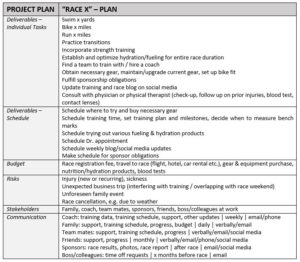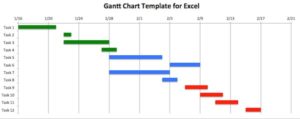Approaching training and racing with a project manager’s mind, can help us stay organized, set the right priorities, and not overlook any important aspects. And, it makes training and racing more enjoyable as we feel more in control while having clear goals in mind.
Every race is basically a project. It has a beginning (when we are pondering whether to sign up), a middle (everything between sign up and race day), and an end (race day). But there is more to this. Let’s apply the project management frame work to our project “Race X”. Here are the 5 general steps of managing any project:
- Setting a Goal
- Planning Phase
- Executing the Project
- Project Completion & Celebration
- Project Review and Lessons Learned
Step 1 – Setting a Goal and Pre-Assessment
This step defines whether the project will take off at all, and if so, what goal(s) it is aiming to accomplish. Just because we have a great idea or inspiration for a project (Race X), does not need to mean it is achievable or realistic. There two important questions to ask before embarking on any project (Race X):
1) What is the purpose of this project (Why am I doing this race)?
2) How does this project fit into the overall business objectives (What is my long term goal)?
There are many ways to answer these questions. For a triathlon race, potential answers to 1) could be: trying a new sport/challenge, having fun, competing with team mates, setting a new PR, qualifying for the next level, etc. And for 2) it could be an equally wide spectrum, such as lifetime fitness, supporting a specific cause/charity, obtaining a pro license, qualifying for Kona. Whatever our dream is.
Now, in order to assess whether the set goal for this specific race is realistic or not, other factors need to be considered before making the final decision, for instance:
- Time left until race day
- Gear and equipment, and funds needed to obtain them
- Current fitness level, and injuries
- Available training time
- Conflicting obligations, business trips, or family events
- People potentially affected or to be consulted
- Overall costs (e.g. registration fees, flight/hotel, gear, coaching fees)
- Overall benefits (e.g. various physical, mental and social benefits, donation to charity, learning, moving closer to reaching one’s dream)
Based on these factors and a quick cost-benefit comparison, we are likely in a good position to decide whether it is realistic to start the project (Race X). If the benefits outweigh the costs, we can go ahead and sign up for the race!
Step 2 – Planning Phase
Now that we have signed up for the race, the planning starts. The most obvious task that comes to mind is planning the training itself. But there are a number of other aspects that shouldn’t be overlooked. From a project management’s point of view, the planning phase is characterized by defining and specifying the project’s deliverables (tasks, schedule), the budget, the risks, the stakeholders and the communication.
Briefly, the deliverables are the specific outcomes that the project should achieve if it is successful, and are usually broken down into individual tasks and the tasks are arranged in a project schedule.
The budget is the available funds within which the expected project costs should lie.
The risks are factors that could negatively affect the outcome or completion of the project. This includes finding ways how to mitigate those risks.
The stakeholders are all those people who are accountable and responsible for the tasks’ fulfillment, are interested in the outcome of the project, or need to be consulted.
Communication is a very crucial in project management in order to keep all involved parties up to date. A communication plan details who needs to be informed when, about what, by whom, and by which means.
Here is an example how this can look like for our project “Race X”.
Once the individual tasks have been identified, they can be put into the format of a training plan and an overall schedule for non-training related tasks. This can take on various forms. A coach can also help with a training plan. Setting milestones (e.g. complete bike fit by end of April) will help to not overlook anything important and to get it done in time.
Know the set budget and consider alternative options or work-arounds to stay within its limits (e.g. renting a wetsuit vs. buying one).
There is always something that can go wrong along the way or comes up last minute to derail our plan. Anticipating potential risks can go a long way to be prepared and have a contingency plan. This includes estimating the likelihood and the impact of a risk (e.g. a race getting cancelled due to poor weather (low likelihood, high impact) vs. cancelling a training week due to an unexpected business trip (high/medium likelihood, low impact if training can be rescheduled/modified).
Although we are accountable and responsible for our own training, we are interconnected with many other triathletes and non-athletes on various levels. Anybody interested in or curious about our goals, our progress and our well-being as a person, can be considered a stakeholder. As their involvement and interest in our athletic pursuits vary, so varies the level and depth of our communication with them regarding our upcoming race. A communication plan might come in handy if we have deadlines by which we need to check-in with our coach, report back to sponsors, or need to request time off from work.
There are various project management tools that can be used depending on how complex and ambitious our race goal is and on how much structure we find helpful. Not every project needs a Gantt chart or a RACI matrix … but just to give an idea:
- A RACI matrix defines who in the project is responsible and accountable for specific tasks, who needs to be consulted, and who needs to be informed. This helps as well with the scheduling and communication plan.
- A Gantt chart shows the individual tasks and their completion date as well as milestones, and indicates who is responsible and/or accountable for the completion of the task. It also includes the dependency of a task from other tasks (e.g. research bike models and consider budget > purchase a bike > bike fit > bike training).
Step 3 – Execution of the Project
Once the project plan has been set, the project can take off. Project implementation in general is a cycle of doing the set tasks, making progress, checking against milestones, keeping track of changes to the plan, monitoring the risks, logging any progress as well as any issues, and communicating the progress, issues, and changes to stakeholders as necessary.
For our “Race X”, this means we begin with the training plus all the other tasks we have identified as being required, and in the same sequence as set out in the project schedule. But, a plan is just that – a plan. There will be changes that we need to adapt to, adjust our plan accordingly, and keep our stakeholders informed of (e.g. the running shoe model we love is not being made anymore and we need to find a new one (extra time and maybe more budget needed; consult with coach, physical therapist, family), or a training milestone is not achieved (a re-evaluation of the training plan or other life factors might be necessary; discuss with coach, family, team mates)).
Thus, amendments to our plan are to be expected. Keeping a training log to track any issues, to record which changes were implemented, and to remember which stakeholders were affected, consulted and informed, is an important part of this step.
Step 4 – Closing the Project
A project is successfully completed when its stated goal has been achieved within the set time frame and budget.
Race day can be seen as the day were we finish project “Race X”. The actual project completion happens when we cross the finish line – which is always an achievement in itself – regardless of whether we met our specific goal or not. But we need to keep in mind that even on race day there will be factors beyond our control that can mess up our plans and lead us to not meeting the goal we set out to achieve. However, with our project management approach, we took care of most aspects that were within our control prior to race day.
Completing a project should be celebrated, regardless of the exact outcome. This is also a good time to thank all those who made it possible in the first place – in case of “Race X” – our stakeholders and our bodies.
However, one last project management step remains.
Step 5 – Project Review and Lessons Learned
After a project is officially completed, the project should be reviewed, feedback collected and identified what was learned and can be improved, including communicating these insights to all necessary stakeholders.
For our Race X, it is thus time to review the race results, analyze what went well, what did not go well and why. This is an important last step so that we don’t repeat the same mistakes. It will help us understand what and where we can improve, and how. At this point, we can also revisit our goals and check if they are still achievable and align with our big dream.
Asking for external feedback from our coach, team mates, our family or other stakeholders is one option. Using our own training log and race data is another option. Sometimes we know exactly what we need to work on, and sometimes we need to dig for an answer until we understand the root cause of an issue.
Here is an example: The goal was to set a PR on this course, but it was not achieved because the bike split time was slower than anticipated.
Potential external factors could have been: wind, road conditions, hills, heat. These factors can only be controlled to a certain extent, but we can prepare ourselves better by training in the heat, on windy days, pre-ride the bike course, and train on hills.
Potential internal factors might have been: fatigue, GI issues, lack of strength. Maybe the fueling and hydration plan needs to be reviewed, paying close attention to what we eat and how much we rest prior to race day might be important for future races.
Outlook
These are the steps for just one project (race). It will get more complex as soon as we sign up for multiple races, with A and B races and training races mixed in. Add to that list open water swims, run events and Gran Fondos, and it truly gets complicated. To schedule an entire race season where we are dealing with overlapping projects and training schedules, a Gantt chart might eventually come in handy.
Author Bio
Sybille Rex is an age group triathlete who has been training, racing and competing since 2013. In 2017, she completed her first 70.3, and qualified for the ITU Sprint Draft-Legal World Championship in Rotterdam. She is also a proud mom of two girls, and a business professional with a strong passion for project management. In addition, she loves to write about anything triathlon-related, maintains a blog at https://teamusaquest.blogspot.com/, and a FB page https://www.facebook.com/Triathlete.SybilleRex/ where she can be followed.




